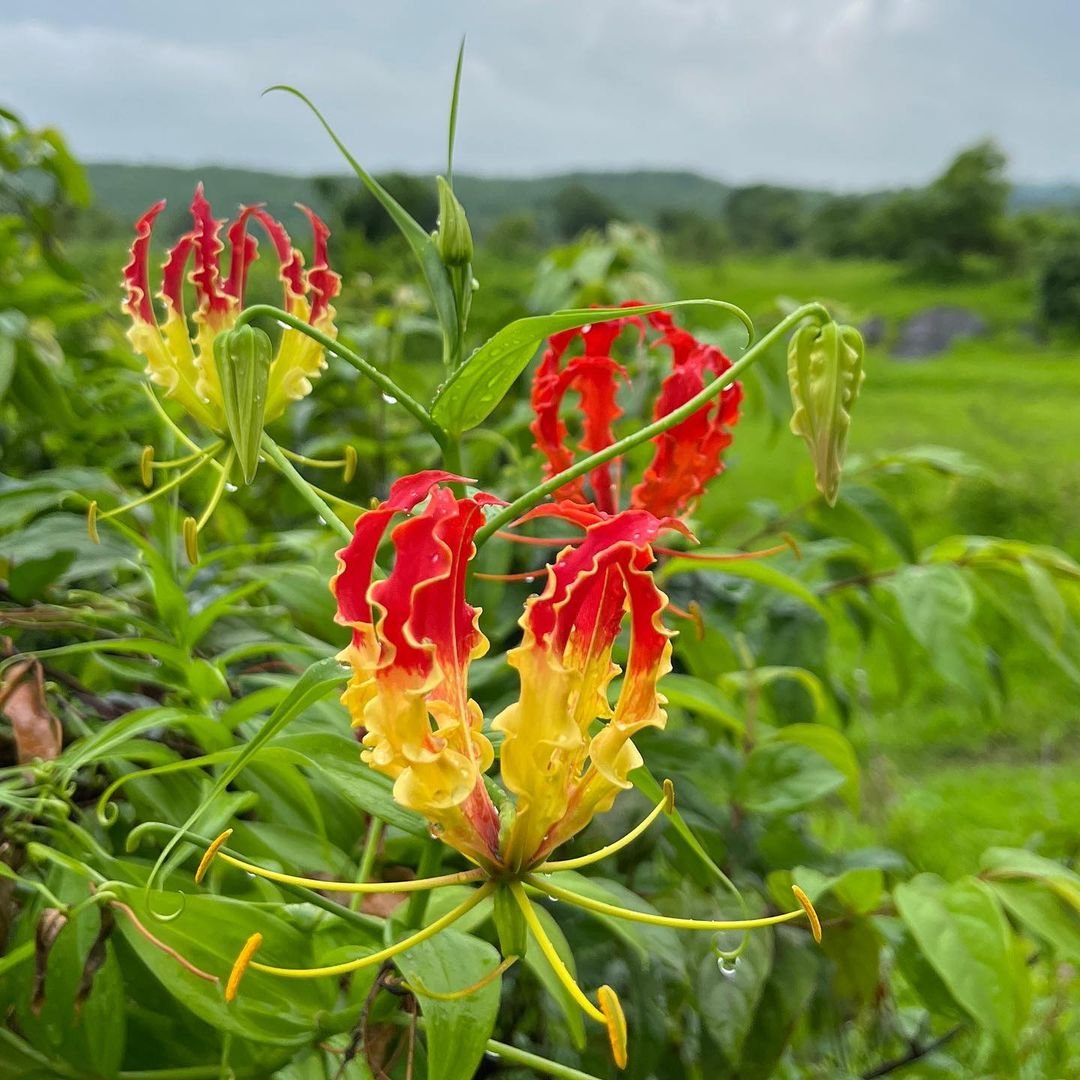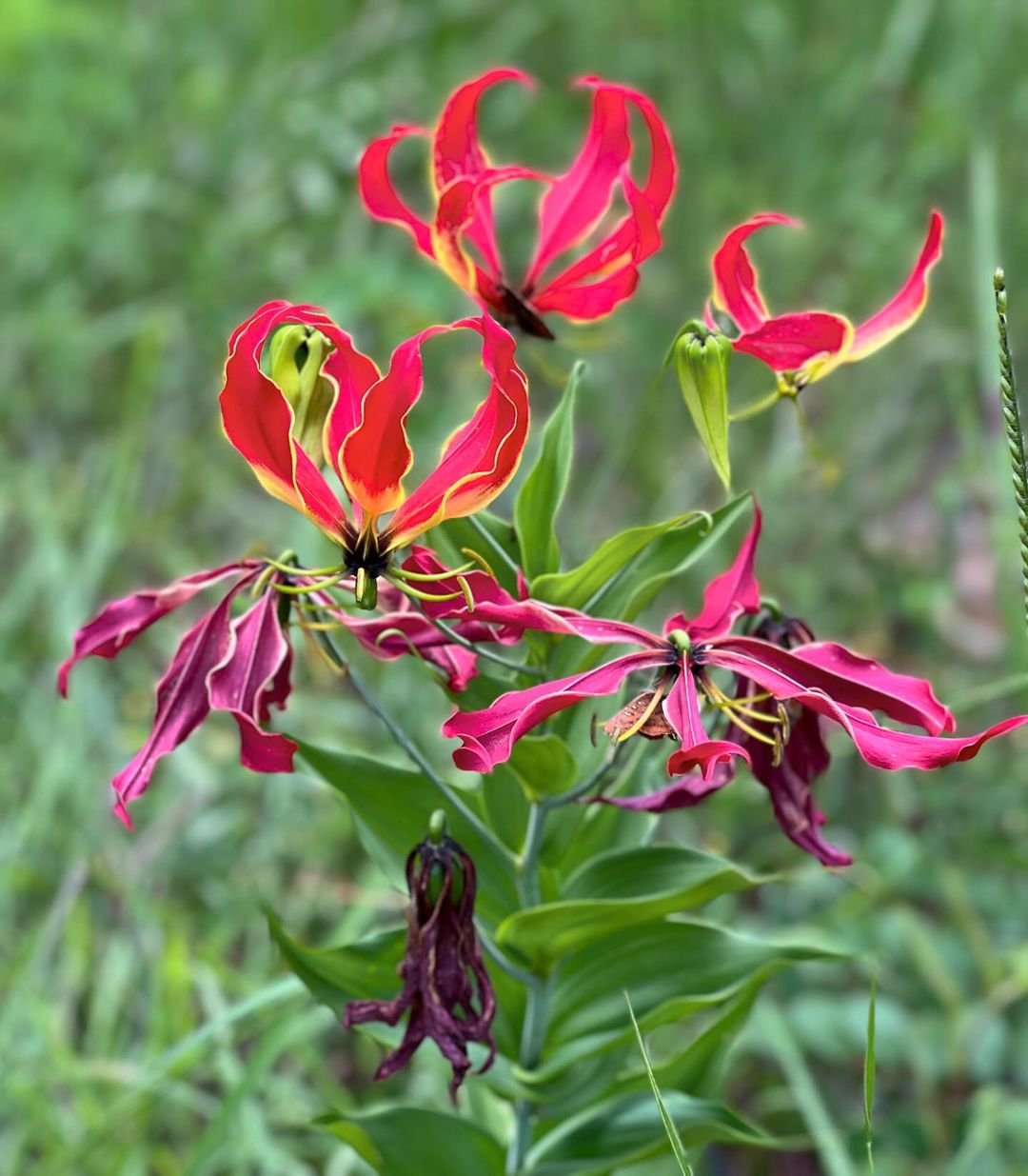Discover the secrets to successfully growing and caring for Flame Lily with our comprehensive guide. Learn expert tips on planting, watering, pruning and maintaining these stunning flowers to ensure vibrant and healthy blooms in your garden.
If you’re a fan of exotic, vibrant flowers, you’ll love the flame lily. This stunning plant features clusters of red-orange tubular blooms that resemble flickering flames – hence the name. Growing flame lilies is relatively easy if you get the basics right. Let’s dive into everything you need to know about this eye-catching beauty.
What is a Flame Lily?

Here’s a short information chart about the Flame Lily (Gloriosa superba):
| Aspect | Information |
|---|---|
| Botanical Name | Gloriosa superba |
| Common Name | Flame Lily |
| Plant Type | Perennial vine |
| Zones | USDA zones 9-11 |
| Sun Exposure | Full sun to partial shade |
| Soil Type | Well-drained, fertile soil |
| Watering | Moderate; keep soil evenly moist |
| Growth Habit | Climbing vine |
| Height/Spread | Up to 6-8 feet tall, spreading vine |
| Special Features | Striking red and yellow flowers, toxic if ingested |
The flame lily (scientific name: Kniphofia uvaria) is a perennial flowering plant native to South Africa. It’s a member of the Asphodelaceae family and gets its common name from the red-hot poker-shaped flower heads.
These plants produce dense clusters of tubular flowers in shades of red, orange and yellow atop tall, thick green stems. The flowers bloom from late spring through summer, providing a sizzling burst of color in gardens.
Flame lily plants can grow up to 4-5 feet tall when mature, with strap-like semi-evergreen leaves forming a dense clump at the base. Their exotic look and ability to attract hummingbirds and butterflies make them a popular choice for landscaping.
Growing Conditions for Flame Lilies

Like most plants, flame lilies thrive when their specific growing needs are met. Here are the ideal conditions:
Sun Exposure
These sun-lovers need at least 6 hours of direct sunlight per day. Full sun is best, but they can tolerate partial shade – especially in hot climates.
Soil
Flame lilies prefer well-draining soil that’s moderately fertile and slightly acidic (pH 6.0-7.0). Sandy or rocky soils are ideal as they prevent waterlogging.
Water
During the growing season, keep the soil evenly moist but not saturated. Allow the top inch or two to dry out between waterings. Reduce watering in winter.
Temperature
Originating from warm South African climes, flame lilies can’t tolerate freezing temperatures. In cold regions (Zones 5-6), they’re treated as annuals or the rootstock is dug up and overwintered indoors.
Where to Plant Flame Lilies
Flame lilies make a bold statement in sunny borders, rock gardens, raised beds or containers. Their vertical shape works well for creating eye-catching focal points or backdrops in landscaping.
Plant them in groups of 3-5 for maximum impact. Space each plant 12-18 inches apart, further for larger varieties. Flame lilies also attract pollinators when planted near vegetable gardens.
If growing in containers, use a large, well-draining pot (at least 12 inches wide and deep) with a quality potting mix.
How to Plant Flame Lilies
Plant flame lily bulbs or divisions in early spring, after the last frost has passed. Here are the steps:
- Prepare the planting area by digging an 8-10 inch deep hole and amending the soil with compost or manure.
- Set the bulbs or rhizome divisions 6-8 inches deep and 12-18 inches apart, with the growing points facing up.
- Cover with soil and water thoroughly after planting.
- Apply a 2-3 inch layer of mulch (bark chips, pine straw) to retain moisture and discourage weeds.
- Water regularly during the first season to establish deep roots.
Ongoing Care for Flame Lilies

With their tropical origins, flame lilies require attentive care – especially during hot summers. Follow these tips:
Watering
Keep the soil consistently moist during active growth, providing about 1 inch of water weekly (more in extreme heat). Reduce watering in fall as plants go dormant.
Fertilizing
Feed flame lilies in early spring using an balanced fertilizer or compost to promote lush foliage and more flowers.
Deadheading
Remove spent flower stalks down to the base to encourage more blooms and neaten the plant’s appearance.
Winter Care
In cold climates, cut back stems to the ground after frost and cover the area with 4-6 inches of mulch. Lift and overwinter tender bulbs indoors if extreme freezing is expected.
Dividing Flame Lilies
These vigorous plants may need dividing every 3-4 years as clumps get overcrowded. Carefully dig up the rootstock and separate the rhizomes in early spring.
Common Problems and Solutions

Though generally low-maintenance, flame lilies can sometimes experience a few issues. Here’s how to troubleshoot:
- Yellowing Leaves: Usually a sign of overwatering or poorly draining soil. Allow the soil to dry out and improve drainage.
- No Flowering: Insufficient sunlight is the main culprit. Relocate plants to a sunnier spot or prune surrounding plants for more light.
- Leaf Spots: Watch for fungal diseases like red leaf spot which cause reddish-brown spots or blotches. Remove affected foliage and treat with an appropriate fungicide.
- Aphids or Mealybugs: Check undersides of leaves for these common sap-sucking pests. Dislodge with a strong spray of water or use insecticidal soap.
Varieties of Flame Lilies

While the classic Kniphofia uvaria is most widely grown, there are several other flame lily varieties that offer unique colors and growth habits:
- K. rooperi (Roopers Poker): Features apricot-orange flower spikes reaching 6 ft tall.
- K. caulescens (Regal Flame Lily): Bicolor red-yellow blooms up to 5 ft in height.
- K. hirsuta (Canes Poker): Dwarf variety with fuzzy foliage and 2 ft spikes of greenish-yellow flowers.
- K. linearifolia (Granalu Flame): Compact 18-inch plants with golden-orange blooms.
Check plant tags for hardiness and specific growing needs when selecting different flame lily cultivars.
Using Flame Lilies in Landscaping

With their vertical flower spikes and bold colors, flame lilies make for dazzling landscape plants. Here are some creative design uses:
- Plant in a sunny mixed border alongside other heat-loving perennials like coneflowers, daylilies and ornamental grasses.
- Use as a “thriller” plant in large containers combined with complementary “filler” and “spiller” plants.
- Create a vibrant focal point by planting flame lilies in groups along pathways or entrances.
- Include them in butterfly and hummingbird gardens to attract pollinators.
- Cut stems make excellent, long-lasting additions to fresh flower arrangements.
With their easy-care nature and showstopping beauty, it’s no wonder flame lilies (also called red hot pokers) are beloved flowering plants for so many gardeners. By providing the right growing conditions, you can enjoy these fiery blooms igniting your landscape all season long.
No garden is complete without eye-catching focal points and conversation starters. The flame lily delivers both in one extraordinary package. From its striking red-orange pokers to its lush, evergreen foliage, this South African native commands attention while requiring minimal maintenance.
Whether planted in borders, containers or wildflower meadows, flame lilies bring bold texture and vibrant color to any sunny spot. They’re also an excellent choice for attracting pollinators like hummingbirds and butterflies to your yard. With so much to offer, it’s easy to see why this unique perennial remains a favorite among green thumbs everywhere. Start growing flame lilies today and experience the sizzle for yourself!
Pingback: Lily of the Valley Flowers: A Complete Guide
Pingback: Natural Beauty: Majestic Trees That Start with ‘H’